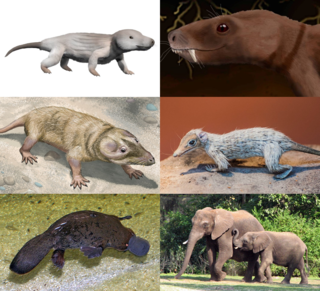
The cynodonts are a clade of eutheriodont therapsids that first appeared in the Late Permian, and extensively diversified after the Permian–Triassic extinction event. Cynodonts had a wide variety of lifestyles, including carnivory and herbivory. Mammals are cynodonts, as are their extinct ancestors and close relatives, having evolved from advanced probainognathian cynodonts during the Late Triassic. All other cynodont lines went extinct, with the last known non-mammalian cynodont group, the Tritylodontidae, having its youngest records in the Early Cretaceous.

Fruitafossor was a termite-eating mammal endemic to North America during the Late Jurassic epoch.

Hadrocodium wui is an extinct mammaliaform that lived during the Sinemurian stage of the Early Jurassic approximately 195 million years ago in the Lufeng Formation of the Lufeng Basin in what is now the Yunnan province in south-western China (25.2°N 102.1°E, paleocoordinates 34.3°N 104.9°E). It is considered as the closest relative of the class Mammalia.
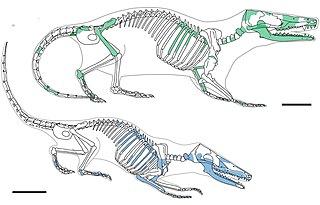
Docodonta is an order of extinct mammaliaforms that lived during the Mesozoic, from the Middle Jurassic to Early Cretaceous. They are distinguished from other early mammaliaforms by their relatively complex molar teeth, from which the order gets its name. Until recently, Docodonta were represented primarily by teeth and jaws found across former Laurasia,. However, recent discoveries in China include some exceptionally well preserved, almost complete body fossils.

Mammaliaformes ("mammal-shaped") is a clade that contains the crown group mammals and their closest extinct relatives; the group radiated from earlier probainognathian cynodonts. It is defined as the clade originating from the most recent common ancestor of Morganucodonta and the crown group mammals; the latter is the clade originating with the most recent common ancestor of extant Monotremata, Marsupialia, and Placentalia. Besides Morganucodonta and the crown group mammals, Mammaliaformes includes Docodonta and Hadrocodium as well as the Triassic Tikitherium, the earliest known member of the group.

Docodon was a mammaliaform from the Late Jurassic of western North America. It was the first docodontan cynodont to be named.

The family Peramuridae is a family of mammals that lived in the Late Jurassic and Early Cretaceous. They are considered to be advanced cladotherians closely related to therian mammals as part of Zatheria.
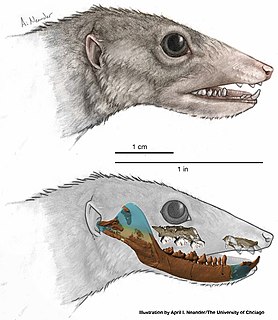
Haramiyida is a possibly polyphyletic order of mammaliaform cynodonts or mammals of controversial taxonomic affinites. Their teeth, which are by far the most common remains, resemble those of the multituberculates. However, based on Haramiyavia, the jaw is less derived; and at the level of evolution of earlier basal mammals like Morganucodon and Kuehneotherium, with a groove for ear ossicles on the dentary. If they are early multituberculates, they would be the longest lived mammalian clade of all time. However, a more recent study, in November 2015, may dispute this and suggested the Haramiyida were not crown mammals, but were part of an earlier offshoot of mammaliaformes instead. It is also disputed whether the Late Triassic species are closely related to the Jurassic and Cretaceous members belonging to Euharamiyida/Eleutherodontida, as some phylogenetic studes recover the two groups as unrelated, recovering the Triassic haramiyidians as non-mammalian cynodonts, while recovering the Euharamiyida as crown-group mammals closely related to multituberculates.

Dryolestida is an extinct order of mammals; most of the members are mostly known from the Jurassic and Cretaceous. They are considered members of the clade Cladotheria, close to the ancestry of therian mammals. It is also believed that they developed a fully mammalian jaw and also had the three middle ear bones. Most members of the group, as with most Mesozoic mammals, are only known from fragmentary tooth and jaw remains.
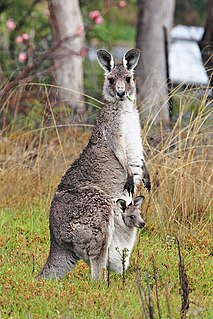
Trechnotheria is a group of mammals that includes the therians and some fossil mammals from the Mesozoic Era. In the Jurassic through Cretaceous periods, the group was endemic to what would be Asia and Africa.

Dryolestidae is an extinct family of Mesozoic mammals, known from the Middle Jurassic to the Early Cretaceous of the North Hemisphere. The oldest known member, Anthracolestes, is known from the Middle Jurassic Itat Formation of Western Siberia, but most other representatives are known from the Late Jurassic of North America and the Late Jurassic and Early Cretaceous of Europe. Most members are only known from isolated teeth and jaw fragments. Like many other groups of early mammals, they are though to have been insectivores. They are generally classifed in Cladotheria, meaning that they are considered to be more closely related to marsupials and placentals than to monotremes. They are placed as part of the broader Dryolestida, which also includes the Paurodontidae, and also sometimes the South American-Antarctic Meridiolestida, which are often considered unrelated cladotherians. Dyolestidae is not based on a phylogenetic definition, but instead on the possession of unequal roots for the molars of the lower jaw. Additionally, the clade is distinguished by hypsodonty in lower molars, and uneven labio-lingual height for the alveolar borders of the dentary.

Amphitheriidae is a family of Mesozoic mammals restricted to the Middle Jurassic of Britain, with indeterminate members also possibly known from the equivalently aged Itat Formation in Siberia and the Anoual Formation of Morocco. They were members of Cladotheria, more derived than members of Dryolestida, and forming a close relationship with Peramuridae. Amphitheriidae is the only family of the order Amphitheriida.

Paurodon is an extinct genus of Late Jurassic mammal from the Morrison Formation of the Western United States.

Triconodontidae is an extinct family of small, carnivorous mammals belonging to the order Eutriconodonta, endemic to what would become Asia, Europe, North America and probably also Africa and South America during the Jurassic through Cretaceous periods at least from 190–70.6 mya.

Brancatherulum is an extinct genus of Late Jurassic mammal from the Tendaguru Formation of Lindi Region of Tanzania. It is based on a single toothless dentary 21 mm in length. It is currently considered either a stem-zatherian or dryolestidan.

Henkelotherium is an extinct genus of dryolestidan mammal from the Late Jurassic (Kimmeridgian) Camadas de Guimarota, in Portugal. Unlike many other Jurassic mammals, it is known from a largely complete skeleton, and is thought to have had an arboreal lifestyle.
Donodon is an extinct genus of mammal from the Ksar Metlili Formation of Talssint, Morocco, which has been dated to the Late Jurassic to Early Cretaceous epochs. The type species D. prescriptoris was described in 1991 by the palaeontologist Denise Sigogneau-Russell. A second species, D. minor, was named in 2022. Donodon was a member of Cladotheria, a group that includes therian mammals and some of their closest relatives. It differed from dryolestids in having upper molars that were not compressed mesiodistally. Some studies have suggested that it was closely related to various South American cladotherians in the clade Meridiolestida, with specific similarities to Mesungulatum, a herbivorous mesungulatid, being noted. On the other hand, a 2022 phylogenetic analysis found it to be only distantly related to meridiolestidans, and instead closer to crown group therians.
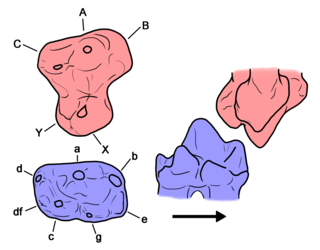
Haldanodon is an extinct docodont mammaliaform which lived in the Upper Jurassic. Its fossil remains have been found in Portugal, in the well-known fossil locality of Guimarota, which is in the Alcobaça Formation. It may have been a semi-aquatic burrowing insectivore, similar in habits to desmans and the platypus. Several specimens are known, include a partial skeleton and well-preserved skulls.

Meridiolestida is an extinct clade of mammals known from the Cretaceous and Cenozoic of South America and possibly Antarctica. They represented the dominant group of mammals in South America during the Late Cretaceous. Meridiolestidans were morphologically diverse, containing both small insectivores such as the "sabretooth-squirrel" Cronopio, as well as the clade Mesungulatoidea/Mesungulatomorpha, which ranged in size from the shrew-sized Reigitherium to the dog-sized Peligrotherium. Mesungulatoideans had highly modified dentition with bunodont teeth, and were likely herbivores/omnivores.

Peramus is an extinct genus of cladotherian mammal. It lived in the Late Jurassic and Early Cretaceous of Europe and North Africa.






















